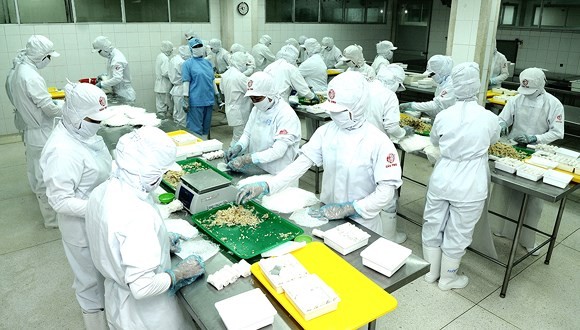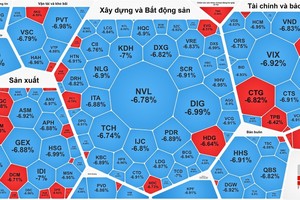
According to foreign firms, factors including expanding market size and increasing expenditure per capita which may reach the level 70 percent of gross domestic products will continue to encourage foreign firms to heavily pour investment into this sector.
Mr Pham Thanh Kien, director of the Ho Chi Minh City Department of Industry and Trade, said that the total goods retail sales was estimated to exceed VND3.3 quadrillion in 2018, of which retail sales of food and drink accounted for 12.3 percent. For Ho Chi Minh City only, of the total retail sales of nearly VND700 trillion, food and drink made up 17 percent.
Foods and beverages are currently taking the largest proportion of about 35 percent in monthly expenses of Vietnamese consumers.
As for export market, export turnover of foods, foodstuffs and farm produce processing industry also surpassed US$40 billion in 2018. Vietnamese products have successfully built brands and passed technical barriers of the world’s most choosy markets, including the US, Japan, South Korea, and the EU. Currently, Vietnamese products have been available in 200 countries in the world. Processed seafood and farm produce products are among 29 items whose export turnover exceeded $1 billion.
Vietnam’s food and foodstuff processing industry is considered attractive because with a diverse and plentiful material source for farm produce and foodstuffs manufacturing the country is viewed as one of five food baskets of the world. Processed food products of Vietnam have been known widely and become more and more popular thanks to businesses’ efforts to build brand names for Vietnamese products.
In addition, favorable factors such as high market concentration ratio, young and crowded population, along with quick adaptation to processed foods have lured foreign investors to join this sector.
Preliminary statistics in the past five years showed that several well-known food manufacturers have set up factories in Vietnam and ceaselessly increased investment as well as purchase, merger and acquisition activities in this sector.
For instance, CJ Group has respectively raised its stakes in Vietnamese large food processing companies, including Cau Tre Export Goods Processing Joint Stock Company and Minh Dat Company. Moreover, in the future, as the State tends to divest investment in top food and beverage producers like Habeco and Vinamilk, foreign investors will strongly pump capital into this sector.
Along with investment into manufacturing, the strategy to dominate processed food market was also carried out by increasing the number of supermarkets, shopping malls and convenience stores. So far, big retailers and distributors, including Circle K, 7-Eleven, B’s mart, Family Mart, Ministop, BigC, Aeon, Auchan and Lotte have set foot in Vietnam with an estimated 3,000 convenience stores and 300 shopping malls and supermarkets across the country.
There are 203 supermarkets, 46 shopping malls and 2,279 convenience stores in Ho Chi Minh City, one of the markets with strongest purchasing power in the country, up 3 shopping malls and 507 convenience stores compared to the end of 2017.
Mrs Ly Kim Chi, chairwoman of the Food and Foodstuff Association of HCMC, concerned that investment wave from foreign investors would increase competition pressure on local firms, especially when the number of small and medium size enterprises accounts for 98 percent. In addition, foreign manufacturers and distributors have cooperated to carry out strategies to dominate Vietnamese market. For instance, distribution networks reduce discount rate and slotting fees for manufacturers while manufacturers lower product prices or increase promotional campaigns.
At the same time, foreign distributors set several barriers such as quality standards, product packing, product net weight and high discount rate in order to prevent Vietnamese products to entering their distribution networks.
Therefore, it is essential to renew competitive advantage of Vietnamese enterprises amid the current situation. Dr Huynh Thanh Dien from the Ho Chi Minh City University of Economics said that in order to regain competitive advantage, local firms should take initiative in improving manufacturing capacity, product quality and design to meet global standards. In long term, local firms should think of approaching global goods supply chain.
As for local authorities, they should apply preferential policy fairly between local and foreign firms in order to avoid the current situation in which foreign firms receive preferential policy on land rental and tax whereas local firms have to rely on themselves. It is urgent that local authorities should prevent unfair competition when foreign firms collaborate together to uproot local firms right on their home ground by underselling.
According to Mr Pham Thanh Kien, there are 5,515 production facilities in the food and foodstuff industry, with nearly 2,000 businesses in operation in Ho Chi Minh City. Vietnam’s food and foodstuff processing industry is attractive not only because of domestic consumption but also because of the country’s processed food and farm produce export prospect.
























